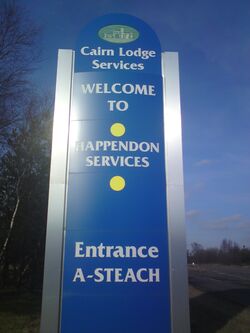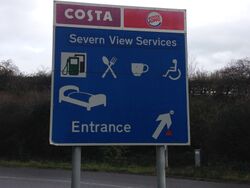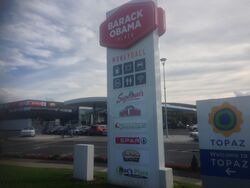How are motorway services named?

Today, service stations are developed by the private sector who can use whatever name they like. Generally, developers like to use names that refer to well-known places.
There is a rule that the name which is used on road signs must be a "geographical" name, but that's a very vague rule which has allowed Cairn Lodge, The Buck and Family Farm to be used.
There are two examples of services which were promoted under a brand name and then changed to a specific one: Gloucestershire Gateway became Gloucester in 2014, and Stop 24 became Folkestone in about 2010. This suggests that the vague "geographical" rule may have some weight.
The oddest service area name in the UK is Pont Abraham. It is named after a bridge that no longer exists, and that bridge was named only in Welsh.
Government documentation uses a number of fictional names to avoid inadvertently promoting a service area.
Complications
Each individual brand will want to refer to their branch by a name that is unique to their business. This means one particular service area may be promoted under several different names. In particular, petrol stations that have been there a long time may still use the name of a local landmark that is no longer relevant, while hotels will want to use the name of a major landmark.
Locals to the area may prefer to use a local nickname, and if you're looking through the history then there is another name to look out for: during development services are often known by the farm on which it is going to be built on.
Naming after a major city can cause complications when new services open. There are at least three services which want to be known as Doncaster, while Welcome Break's Peartree is closer to Oxford than their own Oxford. Signed service areas will try to make each name unique, while each individual operator will want to avoid any duplication within their own estate.
In 2012, the List Sign was changed to use service area names rather than operator names. This can cause confusion when names of far-away cities are used.
History

Until 1992, most service area plans started with the government. As a result, they would usually choose sober names, based on the nearest village or hamlet, and while the operator could ask for the name to be changed, it was never really worth the effort.
Quite a few things changed in the 1990s. Firstly, operators started developing their own service area locations, with the Highways Agency having the role of approving the plans. The operators were later given the power to change their own road signs themselves, making renaming easier. This all gave operators the opportunity to chose more glamorous names, usually based on larger towns.
Another factor was the roll-out of motorway hotels. Big city names made it easier to promote the hotel, so this was another reason why service areas no longer wanted to be named after small places. Granada, in particular, went absolutely crazy, and promoted all of their sites by the name of the nearest town, even if the road signs weren't updated.
Meanwhile, some service areas didn't want to convince you they were near a big city, but instead were trying to paint a relaxing image of pleasant greenery. That's why some 1990s developments chose names like Cherwell Valley, Birchanger Green and Hopwood Park. In the 2010s those cumbersome names started to be dropped, with Gretna Green and Donington Park losing their suffixes.
In March 2020, Leeds Skelton Lake became the only motorway service area to have two names in its official title. Skelton Lake is in Leeds.
Contentious Names
The very first service area can also claim the very first fight over a name: Watford Gap could have been called Watford, Welton or Watford Village.
In 1970 Washington was one of the first services to be named after a large town, which ruffled the feathers of Chester-le-Street Rural District Council.
One of Granada's many renamings was their suggestion that Hilton Park was "Birmingham North", which caused irritation because it's in Wolverhampton. Likewise Blackburn was reluctantly renamed Blackburn with Darwen.
Different Sides
When a service station has two buildings on either side of the road, most staff know the buildings by where they are, not where the road goes. Thus Frankley northbound is known internally as "Frankley West" because it is to the west of the M5, even though the road is going north.
This becomes especially confusing when a road turns. Thanks to a bend in the M6, at Corley the building to the north of the road ("Corley North") serves the M6 southbound. Winchester is another example, where the western half ("Winchester West") serves the side of the M3 that will take you east. Keele is an even more pedantic example.
Changed Names
The following motorway service areas have had their official name changed over the years. We have included a couple of rumoured ones in there, and the two rest areas which were renamed and re-built. We have excluded names that were only used in planning, or only used locally.
There is some confusion about several Granada sites. In the 1990s, they would promote them under a famous name, even if that name wasn't used on the roads.
| Services | Previous Name(s) |
|---|---|
| Birch | Manchester North? |
| Blackburn with Darwen | Blackburn Interchange, Blackburn |
| Burton-in-Kendal | Burton West |
| Cairn Lodge | Happendon |
| Chester | Hapsford rest area |
| Donington | Donington Park |
| Frankley | Birmingham South? |
| Gretna | Gretna Green |
| Heart of Scotland (Harthill) | Harthill |
| Hilton Park | Birmingham North |
| Lancaster | Forton, Lancaster (Forton) |
| London Gateway | Scratchwood |
| Medway | Farthing Corner |
| Northampton | Rothersthorpe |
| Rivington | Anderton, Rivington, Bolton West, (Chorley), Rivington North/South |
| Sedgemoor | Brent Knoll rest area |
| Severn View | Aust |
| Tibshelf | Chesterfield |
| Washington | Washington-Birtley (Port/Virgo) |
As most A-road service areas aren't named on road signs, there is often no consensus on what they are called, making it difficult to trace any changes. There are some examples though, for example what Shell currently call Buckingham services was called 'Mount Pleasant' by Fina.
Ireland

Official (online) services in Ireland are planned by the government, and use local names coupled with the motorway number.
Unofficial (offline) services are named by developers, and usually refer to larger settlements like Wicklow. The road signs never use these names, except on the M11 where a comparison with other services is required. In that case the signs refuse to use the Wicklow name, and call it Coyne's Cross instead.
In particular, Supermac's like to use branded names. It remains to be seen what the road signs will make of Barack Obama Plaza.